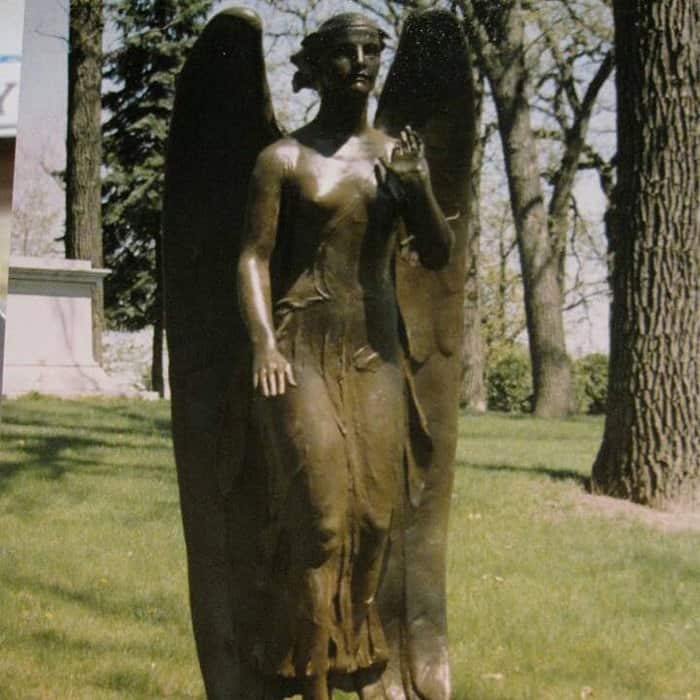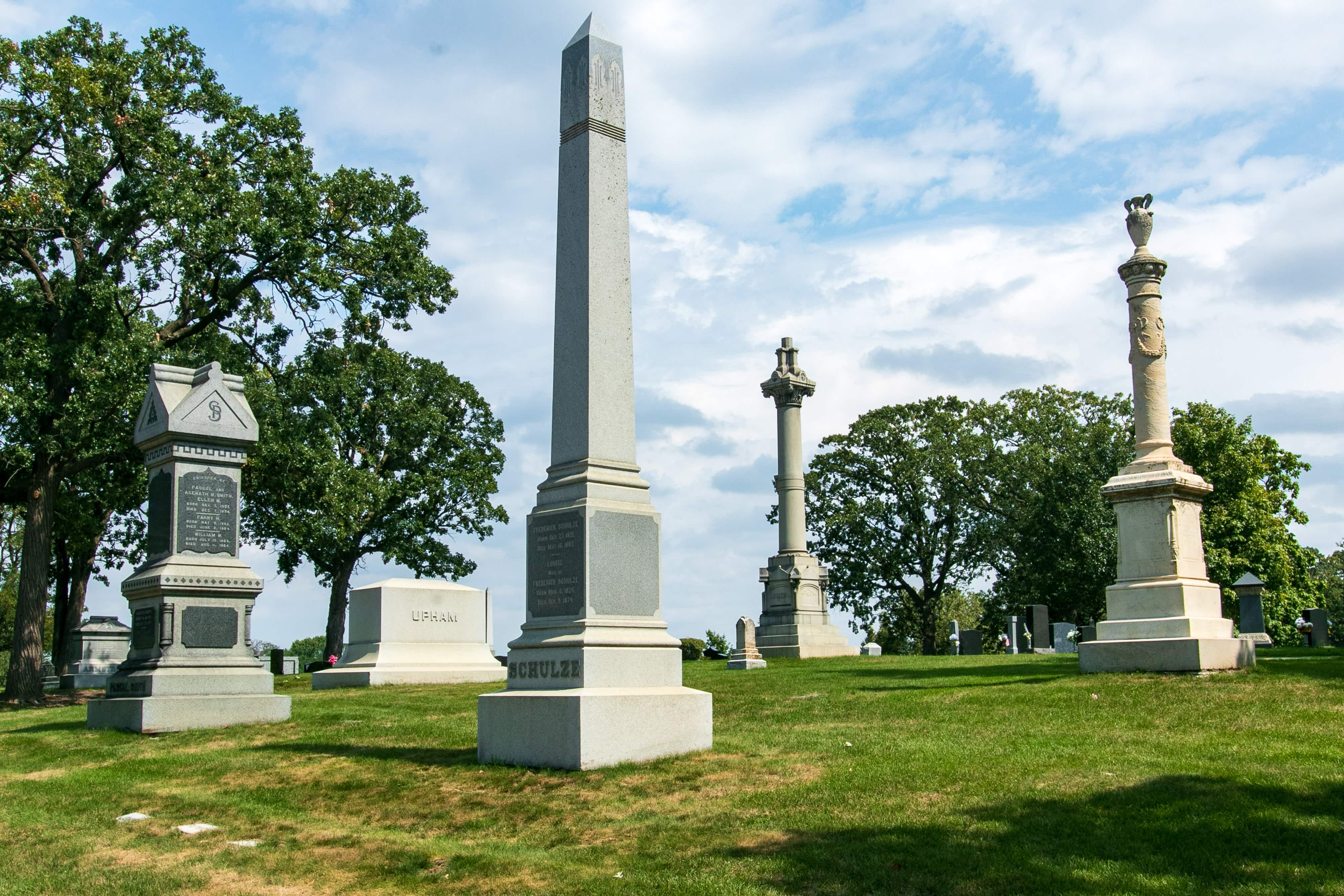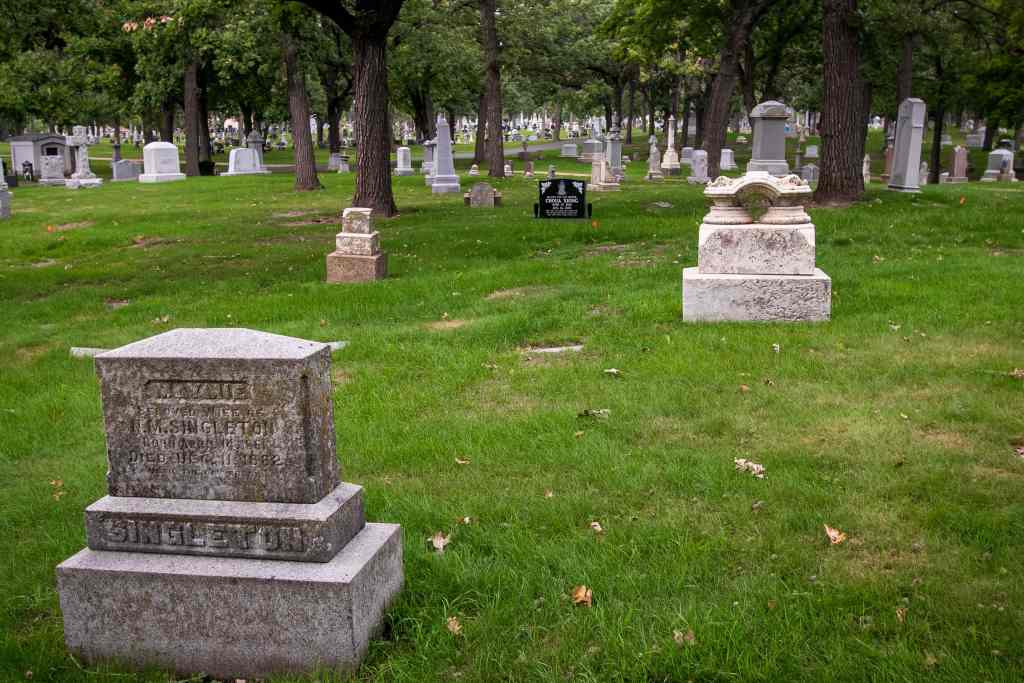21.3 Miles
North End
August 24, 2022
This post picks up where “One Family’s Fascinating History at Oakland Cemetery” left off.
Bobby Schoenrock first set foot in a cemetery shortly after he was born and has been there nearly ever since. As Bobby puts it, “I’ve been around it my whole life.” That’s because his dad, Bob Schoenrock, has worked at Oakland Cemetery for nearly 55 years.
Bobby’s first memories of visiting Oakland Cemetery go back to the late 1980s, when he was five or six years old. He recalls riding with his dad on the cemetery tractor and going to see his grandfather and uncle, who owned Schoenrock Monuments, across Jackson Street from the cemetery. “As I got older, I’d have a little task, like, ‘You can push-mow a little bit of grass over at the shop,’ stuff like that.”
“It was always great ’cause you get to grab a donut and a chocolate milk and then get to go down to work.“
— Bobby Schoenrock on going to visit his dad at work at Oakland Cemetery
Like many boys, young Bobby wanted to be a hockey player, firefighter or police officer. As he got older, those plans faded. The one thing he was sure about was he did not want to work in an office. Was it destiny, then, that he follow his dad in working at Oakland? “Probably not,” he responded, “You just become a part of it.”

Bobby’s favorite part of the cemetery, like his dad’s, is the main entrance. “You have the wrought iron gates. The trees are mature, the big sign is there, and it’s kind of just inviting, like a park-like atmosphere.”



Keeping Oakland Looking Good
Many people misunderstand what the job at Oakland involves. “Funerals are actually maybe 30% of what really happens out on the grounds at a cemetery,” Bobby told me.

The biggest task is caring for the grounds. “We have to maintain 100 acres that’s full of trees and flowers and new grass and roads and waterlines. And there’s just so many things that play into your every day, Monday through Friday, or Monday through Saturday workweek. The funeral portion is just a small piece of it.”
To emphasize his point, Bobby compared the cemetery grounds to a yard. “You see how hard it is to take care of a half acre, an acre or whatever it is at home. Now turn (it) into 100 acres and with a lot of obstacles.”
“In this business we have to kind of be a jack-of-all-trades a little bit. Because we really don’t have money to hire everything out.”
— Bobby Schoenrock
All of that upkeep, burial preparation and equipment maintenance gets done with a surprisingly small troupe of workers. “Normally there’s three of us full time on the grounds, and then my dad, if needed. We’d like to put on five to seven, maybe even more in the summer, but we haven’t had that luxury the last few years with how down the market is job-wise.”
Not-for-Profit
A nonprofit board of trustees created the nondenominational Oakland Cemetery in 1853, and the board continues to oversee its operation. Bobby’s father, Bob Schoenrock, explained, “The board of directors is made up from lot owners. And it’s usually owners of bigger lots, like six grave, 10 grave, 20 grave, that have a real interest in the cemetery.” Many of today’s trustees are descendants of cemetery founders or early trustees, according to Bob. “The Weyerhaeusers, the Shepards, the Lightners. I mean, it’s good old St. Paul families that have a real interest, and then they have some financial clout.”
Still Plenty of Room
“Everybody comes by, they think 1853 and they just look around and see all the big stones and they think it’s full. So I think that’s probably one of the biggest things is that we have lots of room left,” Bobby told me.

Between 56,000 and 57,000 people are buried at Oakland, and Bobby added that there’s room for about 100,000. “We still have a lot of property that is available. It’ll be long past my time, that’s for sure,” before the cemetery is full, and he laughed.
Still, one far-off day the cemetery will reach capacity, and with it, the end of incoming revenue. The trustees planned for that eventuality. “Every lot sale that we have, 20% of it has to go into a fund called a perpetual care fund.” Bobby went on to say, “So that fund is set up so that when the cemetery has no more money coming in, there’s still money to plow the roads, cut the grass, you know, plant the flowers, trim the trees.”
Oakland has some 600 “special care lots,” most of which are huge family lots with 20 or more graves. “A lot of those have special-care money that was set aside a long time ago. And the interest on that money is what we can draw off to take and maintain it; trim the bushes, plant flowers, clean the mausoleums, clean the markers.”

Helping the Grieving
Bobby learned how to respectfully work with people in mourning from watching his dad comfort the grieving at Oakland and his grandfather doing the same at the monument company. “He (Grandpa) could read people so well. He knew when he needed to be compassionate and he knew when he could tell a joke, lighten the mood, and then they could move on.”
Often, Bobby said, clients arrive at the cemetery physically and mentally drained from making arrangements. “Sometimes people will come in here and say, ‘You pick a spot. It doesn’t matter.’ Well, it will three months from now.” In cases like that, Bobby offers to drive them around to find a place they like, or suggests they look around with their family for an appealing final resting spot for the deceased.
Bobby recalled his first solo experience helping a client deal with a relative’s death. “The first time that I had someone come in here and was out with ’em and I’m nervous, ‘cause I don’t wanna say anything that will upset them any more. And I want to try to be compassionate and they start making jokes about the funeral and stuff. And then I was like, ‘What do I do?’ I wasn’t quite sure what I should do, but that’s how they were grieving at that time. And everybody’s different.”
Everybody Is Welcome
While Oakland Cemetery was founded by European Americans, it is nondenominational and welcomes all. “We have so many different cultures and religions that we deal with. It is neat to see how they do things ‘cause everybody does things just a little different.”
Hmong burials became common, so much so that, said Bobby, they “rejuvenated the cemetery.” Many Hmong families settled in nearby North End and East Side neighborhoods, making Oakland a convenient final resting spot. Bobby said the attraction to Oakland is more than proximity. “We hear from them that this cemetery’s a lot like where they came from, whether it was Laos, Thailand, just with the hills, the rolling hills, the trees.”
Changes
Cremation has affected traditional burials, but to a lesser degree at Oakland than elsewhere, according to Bobby. “For us it hasn’t as much as a lot of the other cemeteries. We still do a lot of the Hmong community, which still does traditional burial, and a lot of the other cultures that we do as well do traditional burial.” Surprisingly, in the last decade or so, there’s been a turn toward the past at Oakland as more people are choosing elaborate monuments and markers.



Still, demand for the columbarium was great enough for Oakland to add two more buildings in 2012. “It’s an inexpensive way to put an urn in the wall and then get your name on it, all for a lot less than what it costs to do other things.”
No Ghosts
There’s no better setting for a ghost story than a cemetery. So, while I’m skeptical, I had to ask Bobby — prefaced with an apology — about his experience with ghosts or other paranormal phenomena at Oakland. “We do get this question all the time,” Bobby stated emphatically and added, “No. And we’ve been here, my dad, he can attest … ”
At which point, Bob jumped in. “We had a gal here yesterday, came in and wanted to know about the black angel. And she says, ‘Have you ever experienced any paranormal?’ And I just looked at her and said, ‘No.'”

Then Bobby followed up. “We’ve been down here at all hours and never experienced anything. And the black angel that he (Bob/Dad) was talking about there, that was the story years and years ago about how if you touched it, you would have bad things happen. Well, we’ve all touched it and we’re all still here to tell about it.”
Bobby had at least one possible explanation for the ghost stories: Every couple of years, usually in the heart of the summer when the sun sets around 9 p.m. (the cemetery closes at 8), someone will lose track of time and get locked in. Bobby said the people will call cemetery security, who in turn calls Bobby or Bob. Or the St. Paul Police Department will call them saying someone got locked in.
When one visitor who’d suspected something supernatural mentioned that he’d been locked in a few nights before, Bobby said he replied, “Well, so was I. There was someone (else) locked in here. It was probably them driving around trying to get outta here.”
Getting locked in isn’t necessarily scary, though. “One family, they were around the corner in an area; they were hard to see. And there was three cars and they were all visiting and then they came out and the gates were locked, but they were laughing. They said, ‘He just wanted us to spend a little more time with him. He didn’t want us to leave yet.'”
A Quiet Place To Work
“I don’t think people quite realize too how peaceful it is when you’re out working. You’re doing stuff and you’re working hard, but it’s quiet and it’s peaceful and it’s beautiful outside. The nice days outweigh the bad days, the negative ten and the rain.”

“There’s so many big old, beautiful monuments. There’s the Wilder family. They’ve got a gorgeous monument. And I always look at it and think, ‘How did they get that up there?'”

“A lot of these big, huge monuments with the big granite ball on the top or a statue on top or any of that stuff. How did they do that then? Because today it’s hard enough to do something like that?”
Another Generation of Schoenrocks?
Bobby has two children — a nine-year-old daughter and a 12-year-old son — who love to visit the cemetery. “They did the same thing that I did, They come around when they’re younger and get to have fun and see Grandpa.” Does that mean there will be a third generation of Schoenrocks working at Oakland? Bobby laughed and told me, “I don’t know. I’d probably tell them the same thing he told me. Go do your own thing,” and he laughed again.
Reflections On the Job
Employment at a cemetery is certainly nontraditional, but for Bobby, it’s been quite fulfilling. “I’ve been fortunate to have been able to be a part of this and see my dad and my grandpa and see how to deal with people when they’re at a very hard point in their life.
“And I think it’s helped me through my life, in my everyday life and how I treat people and how I go about doing things. You see things at their worst. You go home, maybe your back’s a little sore or something, but then you remember what did you just do today.”
This article first appeared in Wolfie Browender’s blog, Saint Paul By Bike — Every Block of Every Street. All images are by the author, except where noted.






